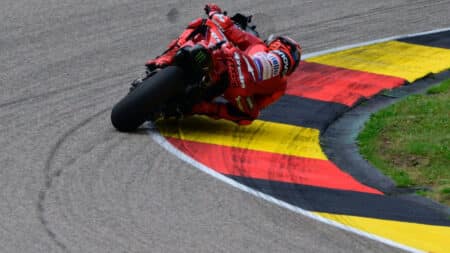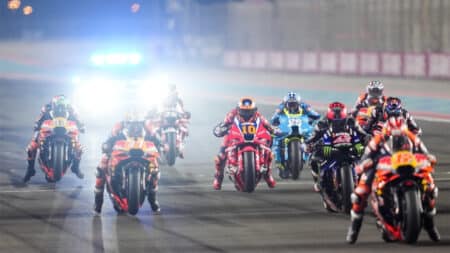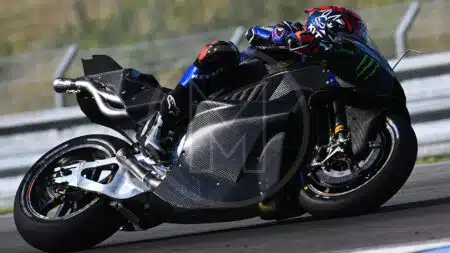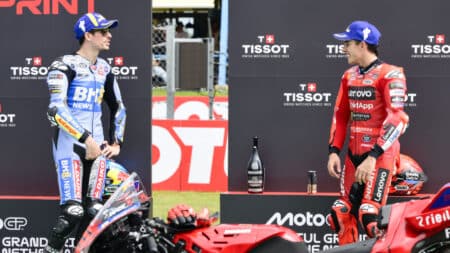Dorna’s Open plan is to get all the factories using their software to make MotoGP racing closer and safer. Open this, Open that, Open the other; that was all everyone was talking about at Sepang last week.

Aleix Espargaró ended the test at the sharp end and ahead of three of the four Factory-spec Yamahas on his Open-spec YZR-M1. It will be a huge thrill to have Espargaró battling up front, putting a few factory noses out of joint.
The even bigger deal at Sepang was Ducati deciding it’s no longer a factory team but is instead an Open team. Honda and Yamaha are raging about this because the whole point of the Open regs was to give poorer privateer teams a helping hand, not to help one factory outflank the others.
That was the spirit of the Open rules, but Ducati’s new chief engineer Gigi Dall’Igna knows that racing isn’t about spirit, it’s about winning: you read the rule book, you exploit it to your advantage and who cares if your rivals hate you?
The big question, of course, is why weren’t the Open regulations written to prevent any renegade factory from exploiting them? It would have been an easy clause to include. Well, the truth is that no clause was included entirely on purpose and precisely to leave the door wide open. And somehow the Japanese never realised someone had left the door swinging in the wind.

The reality is that Dorna want everyone – factories included – running Open bikes as soon as possible, which is why they keep building more and more benefits into the Open regulations.
“We have dangled all these carrots with the intention of getting the factories to seriously consider changing to Open rules, running the Dorna software,” says MotoGP Race Director Mike Webb.
“Our ideal situation is that they will add it all up and say that’s what they want to do because what we want is all the bikes on the grid running under one set of rules. Running two classes [Open and Factory] within the MotoGP class was never our intention; it’s just one step along the road.”
The attraction of the Open class
It was a no-brainer for Ducati to go Open. The extra four litres of fuel and the potential to use softer tyres are largely irrelevant. What really matters is the freedom they get on with engine development and testing. Factory teams are allowed just five engines to last 18 races, sealed at the start of the season, which means zero engine development. This is a cost-cutting measure, to freeze development.

Under Open rules, Ducati can use 12 engines, but more importantly their engines aren’t sealed and they can adjust bore and stroke (banned in the Factory regs), so they can turn up at pretty much every race with an entirely new engine, if they want.
Factory teams are also severely restricted on testing, again to reduce costs. Open teams are not, so Ducati can have Cal Crutchlow and Andrea Dovizioso running around in circles day after day after day, evaluating different engines, different electronics and different chassis.
So Ducati may be able to make a few years worth of progress in just a few months. And that’s great news for MotoGP, whatever the other factories think.
At Sepang there were cries of “conspiracy!” when Magneti Marelli delivered a major new software upgrade to the Open teams, just days before Dovizioso and Crutchlow were due to test the GP14 under Open spec for the first time. And when both riders lapped very close to the Factory-spec lap times, there were gasps up and down pit lane: wow, the new software must be amazingly good.

But neither the Ducati riders nor any other Open riders used the 2014 software at Sepang. They had the new software loaded into their ECUs, but only running in background mode, while the bikes were controlled by the final version of the 2013 Open software.
And this is where it gets complicated. During the offseason Dorna told Magneti Marelli to upgrade their software to help the Open bikes get closer to the factory bikes and to tempt the factories to go Open.
Ducati’s manufacturers’
championship standings
2003: 2nd
2004: 3rd
2005: 3rd
2006: 3rd
2007: 1st
2008: 2nd
2009: 3rd
2010: 3rd
2011: 3rd
2012: 3rd
2013: 3rd
The immediate problem is that the latest software is too complex for the poorer Open teams, who may only have one electronics engineer who’s less knowledgeable than the numerous highly qualified factory electronics boffins. Thus there is a safety issue here: a poorly programmed 210mph MotoGP bike can be a very dangerous thing.
“We’ve had meetings with the Open teams and some said, we’re not ready for the new software, we don’t have enough people,” Webb continues. “At some point they’ll come back to us and say, yeah, we can handle it, or no, we’re going to have to limit its capabilities. Within reason the new system has to be idiot proof.”

The aim of allowing Open teams to run the new software in background mode is to help them learn how it works and how to programme it. Only once most Open teams can cope with the new system will the decision be made to go ‘live’. That may happen in Qatar, or it may happen much later in the season.
Although some of the poorer teams are scratching their heads, the latest Open software is already doing its other job: showing the Japanese factory teams that it isn’t a million miles away from their own – and therefore softening their outright opposition to control electronics.
“Now the factories are prepared to think about using the control software, whereas before it was: ‘no we’re not interested!’” adds Webb. “The great thing is that all the factories now have bikes running the Open software (i.e. the Ducatis, plus Honda’s RCV1000R and Yamaha’s Forward M1s) so it’s no longer an unknown to them, which is a game changer.
“We’ve now got guys from Honda, Yamaha and Ducati giving input to Magneti Marelli, which is one reason the latest upgrade is such an enormous step towards what the factories use.”
The upshot of all this is that MotoGP may (hallelujah!) cease to be a race series with two different sets of technical regulations before 2017, when the next full rule rewrite was expected. Having two different kinds of bike competing in the same race is always bad.

Honda is not happy with Ducati exploiting the Open rules
“We’ve been negotiating, very slowly, heading towards where we want to go,” says Webb. “If all the factories choose to go to Open rules, then MotoGP will all be Open, that’s it.”
That won’t happen this year, because the deadline for opting to go Open has already passed, but it could happen in 2015. And then Dorna can get busy turning down the electronics.
“The dilemma is that we have to show this software is good, but how far do we go, because the final target is to slow things down (with an rpm limit) and get the electronics to a more simple level. For example, we want to see traction control back what it used to be: a safety aid, not a performance aid.
“There is no doubt that our bikes are too fast. They don’t fit on the circuits anymore – we already need more runoff everywhere! So we have to make it less easy to turn on the gas, we need to slow down the top speeds and we need to slow down the lap times.”
Open surely has to be the way to go: cheaper, closer and safer racing. How long before Honda and Yamaha can’t resist Dorna’s carrots?
More from Mat Oxley
The death of US bike racing?
Open season on the factory teams
Silly season or stupid season?
Follow Mat on Twitter












